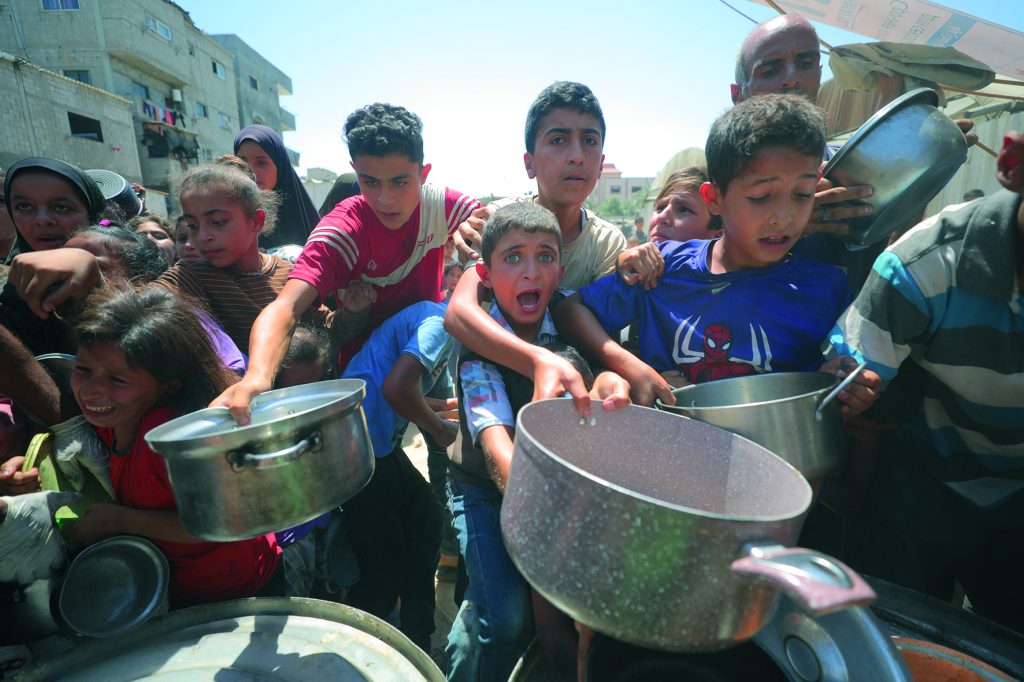What do we know about hunger in Gaza and the Gaza Humanitarian Foundation?
The War in Gaza continues. Since early June, humanitarian aid has been entering the Gaza Strip through cooperation between Israel and the American organization Gaza Humanitarian Foundation (GHF). Opinions about this aid vary widely: some claim that ‘Israel is responsible for the hunger in Gaza’, while others argue that ‘No one is dying of hunger in Gaza’. These are starkly contrasting narratives. On July 23, Gaza’s Hamas-run Ministry of Health reported that twenty people had died of starvation within 48 hours — the highest number recorded so far during the war.
At the same time, the United Nations claims that more than a thousand people have been shot dead by the Israeli army at GHF distribution points. These figures, too, are based on data from the Hamas-controlled health ministry. Israel denies responsibility for the hunger crisis and maintains that no deaths from starvation have been confirmed.
Aid Organizations and Media
All over the world, many have already assigned blame: Israel is accused of deliberately creating hunger in Gaza and luring civilians to GHF distribution sites to shoot them and cause chaos. According to numerous aid organizations, the humanitarian crisis is not a side effect of the war but a direct result of calculated decisions. By limiting aid distribution to the southern part of Gaza, they argue, civilians are being forced to flee the north — an approach they describe as a deliberate strategy of gradual displacement.
More than a hundred aid groups have called on governments to intervene. They demand an end to the obstruction of humanitarian aid, an immediate ceasefire, and the replacement of GHF’s operations with an UN-led relief effort. In doing so, these organizations and much of the international media have largely adopted Hamas’s narrative and figures. Gaza does not have a free press, meaning the information emerging from the territory is controlled by Hamas, Israel, or GHF, which collaborates with Israel. Yet, global media and NGOs disproportionately rely on Hamas’s data, often overlooking other available sources. This raises the question: what do these figures really represent?
Figures from Israel and GHF
GHF claims to have distributed over two million meals per day in recent days, with daily numbers ranging from 500,000 to two million last week. Israel states that humanitarian aid is not being blocked and that roughly 950 trucks filled with aid are waiting just across the border to be delivered into Gaza. According to Israel, there is still no evidence of deaths from starvation. COGAT — the Israeli government body coordinating aid to Gaza—reports that between 450 and over 600 aid trucks enter Gaza weekly through various crossings. Before the war, approximately 75 trucks per day carried food into Gaza, making current figures comparable.
GHF has issued several statements regarding shootings near its facilities, claiming that Hamas, not Israel, was responsible for opening fire on civilians and inciting unrest. Hamas reportedly sees GHF’s operations as a threat to its influence. Israel alleges that when the UN managed aid distribution, Hamas looted food trucks and sold supplies at inflated prices. Under the previous UN aid system, trucks were frequently attacked and looted by armed gangs, preventing humanitarian aid from reaching its intended destinations. Both Israel and Palestinian Authority President Mahmoud Abbas blame Hamas for these actions. GHF was founded to prevent such interference.
While acknowledging the dire conditions in Gaza, GHF is calling on the UN and the World Food Program (WFP) to cooperate. The foundation’s director blames other aid organizations for the backlog of 950 aid trucks, warning that much of the food may soon expire due to delays. Previously, both the UN and WFP declined to work with GHF. However, according to a July 24 report from COGAT on X (formerly Twitter), the UN has now begun collecting these aid shipments.
Anonymous Claims
There are recurring reports quoting anonymous Israeli soldiers claiming they were ordered to shoot civilians waiting for aid. Some GHF security guards are also alleged to have claimed that GHF itself opened fire on civilians at distribution sites. The Israeli embassy in the Netherlands responded: ‘These are always anonymous claims, making them impossible to verify or investigate. When credible reports are made, investigations are launched immediately.’ In response to criticism over past investigative failures, Israeli ambassador to the Netherlands Modi Ephraïm stated: ‘Let me point this out: Many countries make mistakes during war and never admit them. Israel immediately launched an investigation, offered apologies, suspended the responsible commander, and initiated a legal inquiry. Few armies take such accountability.’
Lack of Verifiable Information from Gaza
Verifying facts on the ground in Gaza remains extremely difficult due to the absence of a free press or independent observers. Journalists operate under Hamas supervision, which not only controls media output but also spreads propaganda. Aid organizations and media outlets rely on unverified reports from sources within Gaza. It is concerning that data from Hamas — a designated terrorist organization — are so often taken at face value, while Israel’s accounts, as a democratic nation with a free press, are frequently met with skepticism.
This double standard leads to one-sided pressure on Israel to end the war and resolve the humanitarian crisis, while Hamas’s role is often overlooked. Hamas has repeatedly misrepresented casualty numbers, humanitarian conditions, and its own actions. Yet its narrative is widely accepted without sufficient scrutiny. If that narrative dominates global discourse unchecked, truth will be eclipsed by perception. At the very least, this should give us pause.




